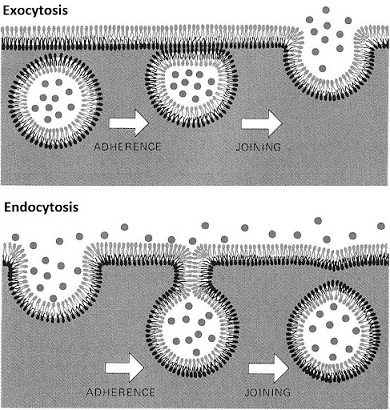
Why is Endocytosis considered a mode of active transport? What process of active transport is the reverse of Endocytosis?
Answer
373.2k+ views
Hint: Living cells require particular substances in concentrations greater than they exist in the extracellular space. Transferring substances up their electrochemical gradients needs energy from the cell. The active mode of transport uses the energy stored in ATP for fueling the transport of substances. Active transport uses integral proteins to move the materials. Some proteins couple directly with ATP to drive the transport of molecules.
Complete answer:
• Endocytosis falls under the category of active transport. It moves particles, like parts of cells, larger substances, and even whole cells into a cell.
• It leads to a particle being enveloped in a newly created intracellular vesicle, which is formed from the plasma membrane. It is a mode of active transport as the cell requires energy.
• Endo means inside. During endocytosis, a cell utilizes the cell membrane for engulfing an object, which is present outside of the cell. This process requires effort by the cell, so it needs to use the energy (ATP).
• Though there are different kinds of endocytosis, all share a common characteristic. Invagination of the plasma membrane happens, forming a pocket around the target molecule.
• The active transport which is the reverse of endocytosis is exocytosis.

Fig. Endocytosis and Exocytosis
• In Exocytosis mode of transport, materials are expelled from the cell without passing through the membrane as individual particles. It is the exact opposite process of endocytosis.
• A particle existing within the membrane fuses with the inside of the plasma membrane and the membranous envelope is opened to the outside of the cell and this expels the particle into the extracellular space.
Note:
• Phagocytosis is a process, through which larger molecules are taken in by the cell. When the human body is invaded by microorganisms, a kind of white blood cell called neutrophil removes the invader, surrounds and engulfs the microbes, later destroying the same.
• Another variation is pinocytosis, which means cell drinking. In this process, the cell takes in the needed solutes from the extracellular fluid.
• A targeted variation of endocytosis is receptor-mediated endocytosis. Proteins present in the plasma membrane of the cell are specific to some foreign substances. The substances bind to the proteins, leading to the invagination of the plasma membrane, bringing the substances inside the cell.
Complete answer:
• Endocytosis falls under the category of active transport. It moves particles, like parts of cells, larger substances, and even whole cells into a cell.
• It leads to a particle being enveloped in a newly created intracellular vesicle, which is formed from the plasma membrane. It is a mode of active transport as the cell requires energy.
• Endo means inside. During endocytosis, a cell utilizes the cell membrane for engulfing an object, which is present outside of the cell. This process requires effort by the cell, so it needs to use the energy (ATP).
• Though there are different kinds of endocytosis, all share a common characteristic. Invagination of the plasma membrane happens, forming a pocket around the target molecule.
• The active transport which is the reverse of endocytosis is exocytosis.

Fig. Endocytosis and Exocytosis
• In Exocytosis mode of transport, materials are expelled from the cell without passing through the membrane as individual particles. It is the exact opposite process of endocytosis.
• A particle existing within the membrane fuses with the inside of the plasma membrane and the membranous envelope is opened to the outside of the cell and this expels the particle into the extracellular space.
Note:
• Phagocytosis is a process, through which larger molecules are taken in by the cell. When the human body is invaded by microorganisms, a kind of white blood cell called neutrophil removes the invader, surrounds and engulfs the microbes, later destroying the same.
• Another variation is pinocytosis, which means cell drinking. In this process, the cell takes in the needed solutes from the extracellular fluid.
• A targeted variation of endocytosis is receptor-mediated endocytosis. Proteins present in the plasma membrane of the cell are specific to some foreign substances. The substances bind to the proteins, leading to the invagination of the plasma membrane, bringing the substances inside the cell.
Recently Updated Pages
Master Class 9 General Knowledge: Engaging Questions & Answers for Success

Master Class 9 English: Engaging Questions & Answers for Success

Master Class 9 Science: Engaging Questions & Answers for Success

Master Class 9 Social Science: Engaging Questions & Answers for Success

Master Class 9 Maths: Engaging Questions & Answers for Success

Class 9 Question and Answer - Your Ultimate Solutions Guide

Trending doubts
What are the elders in Goa nostalgic about class 11 social science CBSE

Define least count of vernier callipers How do you class 11 physics CBSE

Write the differences between monocot plants and dicot class 11 biology CBSE

Which of the following is not a feature of the election class 11 social science CBSE

The mass of oxalic acid crystals H2C2O42H2O required class 11 chemistry CBSE

How many squares are there in a chess board A 1296 class 11 maths CBSE




